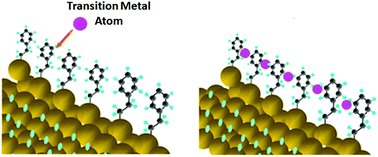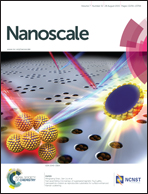Electronic and magnetic properties of silicon supported organometallic molecular wires: a density functional theory (DFT) study†
Abstract
The electronic and magnetic properties of transition metal (TM = Sc, Ti, V, Cr and Mn) atom incorporated single and double one-dimensional (1D) styrene molecular wires confined on the hydrogen-terminated Si(100) surface are explored for the first time by means of spin-polarized density functional theory, denoted as Si–[TM(styrene)]. It is unveiled that TM atoms bind asymmetrically to the adjacent phenyl rings, which leads to novel electronic and magnetic properties in stark contrast to the well-studied gas phase TM–benzene molecular wires. Si–[Mn(styrene)]∞ and Si–[Cr(styrene)]∞ single molecular wires (SMWs) are a ferromagnetic semiconductor and half metal, respectively. Creation of H-atom defects on the silicon surface can introduce an impurity metallic band, which leads to novel half-metallic magnetism of a Si–[Mn(styrene)]∞ system. Moreover, double molecular wires (DMWs) containing two identical or hetero SMWs are theoretically designed. The [Mn(styrene)]∞–[Cr(styrene)]∞ DMW exhibits half-metallic magnetism where the spin-up and spin-down channels are contributed by two single molecular wires. Finally, we demonstrate that introducing a TM-defect may significantly affect the electronic structure and magnetic properties of molecular wires. These studies provide new insights into the structure and properties of surface supported 1-D sandwiched molecular wires and may inspire the future experimental synthesis of substrate confined organometallic sandwiched molecular wires.


 Please wait while we load your content...
Please wait while we load your content...